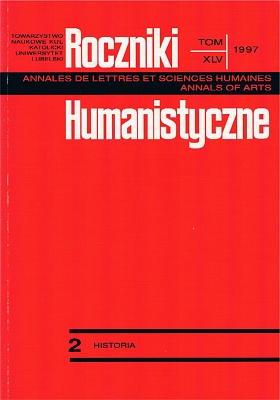The System of Benefices in the Chełm Diocese in the Years 1600-162
Abstract
The organization and functioning of dioceses in modern-day Poland were based on the system of benefices formed by the feudal regime and drawn on the lay feud system. The paper depicts, on the basis of the church sources and the literature on the subject, the structure of benefices in the Chełm diocese, the diocese which belonged to the Lvov metropolis in the beginning of the seventeenth century (the time when bishop Jerzy Zamoyski 1600-1621 was in office). The subject matter of our analysis is the number and location of the benefices, the time of their foundation, the formal-legal situation (especially the duty of residence and ban on hoard), patronage and the state of property.
The organization of the Chełm diocese in the years 1600-1621 was based on 127 benefices placed in 64 places. the unequal distribution of benefices (half of them were concentrated in three centres – Krasnystaw, Zamość, and Uchanie) affected the insular distribution of the laity in the diocese.
The most numerous group is made up of the benefices connected with a pastoral activity – parochial churches (62), cathedral and collegiate curacies (in total 21). The cathedral chapter with its see in Krasnystaw had not changed its form from the time of its foundation in 1429, and consisted in the beginning of the seventeenth century of 10 canonries and 2 prelacies. The organization of the collegiate chapter in Zamość took place when bishop Zamoyski was in office. The chancler Jan Zamoyski founded in it 3 prelacies and 4 canonries. A small number of simple benefices (hospital provostries and altaries) is a result of poor condition of the Latin nobility in those territories, diverse with regard to religion and ethnic roots.
Most of the benefices in the Chełm diocese demanded a permanent residence and excluded a possibility of hoard (beneficia residentaria et incompatibilia). The legislation of the Chełm diocese considerably limited the strict Tridentine constitutions, providing access for canons and prelates to other benefices, and limiting the requirement to reside near the cathedral.
The benefices in the Chełm diocese are characterized by a constant increase of the importance of the nobility patronage. Despite that the best endowed benefices (we mean here mainly parishes) in the beginning of the seventeenth century are the benefices in the fourteenth and fifteenth centuries founded in the royal towns. An exception here is the newly erected collegiate chapter in Zamość, founded by Jan Zamoyski. Its endowment excelled the incomes of the cathedral chapter.
Copyright (c) 1997 Roczniki Humanistyczne

This work is licensed under a Creative Commons Attribution-NonCommercial-NoDerivatives 4.0 International License.





